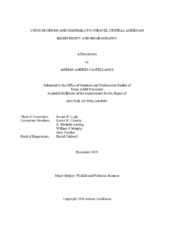| dc.contributor.advisor | Light, Jessica E | |
| dc.creator | Castellanos, Adrian Andrés | |
| dc.date.accessioned | 2020-09-09T20:30:47Z | |
| dc.date.available | 2021-12-01T08:43:03Z | |
| dc.date.created | 2019-12 | |
| dc.date.issued | 2019-09-25 | |
| dc.date.submitted | December 2019 | |
| dc.identifier.uri | https://hdl.handle.net/1969.1/188998 | |
| dc.description.abstract | My work examines the biodiversity and biogeographic patterns of Central American mammals at multiple scales to better understand potential drivers of diversity across this region. Central America is home to a diverse community of species due in part to continental species exchanges, past and recent geologic processes, and glacial climate cycles that have all shaped a fauna that is unique, but also reminiscent of North and South America. To understand the contributions of these influences, I improved current methods to mitigate spatial sampling bias in ecological niche models, determined spatial patterns of mammalian biodiversity and their environmental drivers, and examined comparative phylogeographic patterns of lowland mammal species.
I found that filtering natural history collection occurrence data in environmental space often created more biologically realistic models than filtering in geographic space. Spatial biodiversity patterns of Central American mammals typically varied by order and biodiversity index, with areas diagnosed by low temperature and precipitation seasonality often showing higher overall diversity. Additionally, I found little differentiation within the widespread, lowland mammal species examined, despite the prevalence of many high elevation geographic barriers in Central America. Overall, I have integrated multiple, disparate datasets using natural history collection data to show that Central American mammals interact with the complex geography of this region in complicated and different ways. This work will be useful as we continue to attempt to determine areas of conservation focus and assess biodiversity patterns in this hyper-diverse region. | en |
| dc.format.mimetype | application/pdf | |
| dc.language.iso | en | |
| dc.subject | Central America | en |
| dc.subject | biodiversity | en |
| dc.subject | biogeography | en |
| dc.subject | mammals | en |
| dc.subject | museums | en |
| dc.subject | ecological niche models | en |
| dc.title | Using Museums and Mammals to Unravel Central American Biodiversity and Biogeography | en |
| dc.type | Thesis | en |
| thesis.degree.department | Wildlife and Fisheries Sciences | en |
| thesis.degree.discipline | Wildlife and Fisheries Sciences | en |
| thesis.degree.grantor | Texas A&M University | en |
| thesis.degree.name | Doctor of Philosophy | en |
| thesis.degree.level | Doctoral | en |
| dc.contributor.committeeMember | Conway, Kevin W | |
| dc.contributor.committeeMember | Lawing, Anna M | |
| dc.contributor.committeeMember | Murphy, William J | |
| dc.contributor.committeeMember | Voelker, Gary | |
| dc.type.material | text | en |
| dc.date.updated | 2020-09-09T20:30:47Z | |
| local.embargo.terms | 2021-12-01 | |
| local.etdauthor.orcid | 0000-0002-3412-0487 | |


